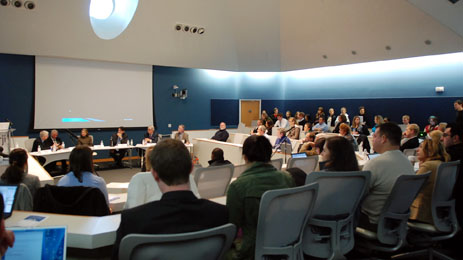Behavioral targeting
Advertising leaders visited RJI on Oct. 14 to talk to professors and students about the importance of ethical advertising. Wally Snyder moderated the discussion with Tim Armstrong, Chairman and CEO of AOL part of the panel. The panel discussed proposed ethical principles to enhance ethics in the advertising industry.
Reynolds Fellow Stephanie Padgett discusses the impacts of behavioral targeting on online advertising and how small to mid-size newspapers can use the technology of online advertising to its advantage.

Behavioral targeting is critical to the success of online advertising
At a recent Reynolds Journalism Institute conference, Tim Armstrong, CEO of AOL, noted that behavioral targeting is critical to the success of online advertising and is beneficial for consumers, advertisers and content providers when done properly. Yahoo, AOL, Google, Facebook and others have sophisticated systems that allow advertisers to segment potential customers by valuable characteristics, such as car buyers, moms or dieters.
True behavioral targeting uses a cookie to mark a user based on online activity
I have personally used this with great success for schools that are looking to reach upscale moms with boys 12-16. To be clear, true behavioral targeting is beyond content targeting — which only allows me to place ads next to relevant content when it’s available. True behavioral targeting uses a cookie to mark a user based on online activity then serves relevant ads to that user as they visit other sites. Thus I can reach a mom who has spent time on Yahoo local school pages as she does her banking, shops for Christmas or catches up on celebrity gossip.
If, as Armstrong purports, behavioral targeting is key to successful online campaigns how can small to mid-size newspapers leverage this technology and can it pay out?
The Tribune company recently announced that they plan to adopt a universal registration platform across all properties “to make it easier for advertiser to target users, according to PaidContent.org. The New York Times has sophisticated systems for targeting visitors and serving ads based on that information. But can papers with online audiences under 100,000 unique visitors capitalize on this trend?
It requires newspapers to think outside the box
I think so, but it requires newspapers to think outside the box, open up their sites and develop partnerships based on the value of segmentation — things newspapers haven’t done so well in the past.
The time has come when newspapers need to STOP proclaiming they are the biggest player in a market and START selling the quality of their readers. Just this week, I received a note from an online rep whose signature tagline proclaimed, “Do you want to reach 84 percent of the online audience in the Milwaukee Market, nearly one million people? Ask me how.”
Newspapers need to understand — the answer is NO —I don’t want to reach one million people, but I would like to talk to the 1,920 women in Milwaukee who are 35+ and mentioned their sons in their Facebook profile. And guess what — I can! Through Facebook ads, I can target a customized message to only those women and the site has become the number one referring site to the school’s website!
So how do newspapers get started—and not just with reselling Yahoo’s audience in their market? Here are three steps that I am researching as part of my fellowship to help newspapers can start benefiting from behavioral targeting with their OWN readers.
- Identify natural segments within a newspaper site that will havestrong appeal to local and/or regional advertisers and create a plan tocookie these segments for ad serving.
- Partner with companies that can enhance the segmentationcapabilities based on their data, rather than just relying on your siteusage in order to create more robust target segments.
- Develop platforms and/or partnerships to market these segments thatbring in new advertisers (both locally and regionally) and increased CPM’s.
If you are a paper with less than 100,000 circulation that is interested in being a partner in this Fellowship project, please contact Stephanie Padgett, padgetts@missouri.edu.
